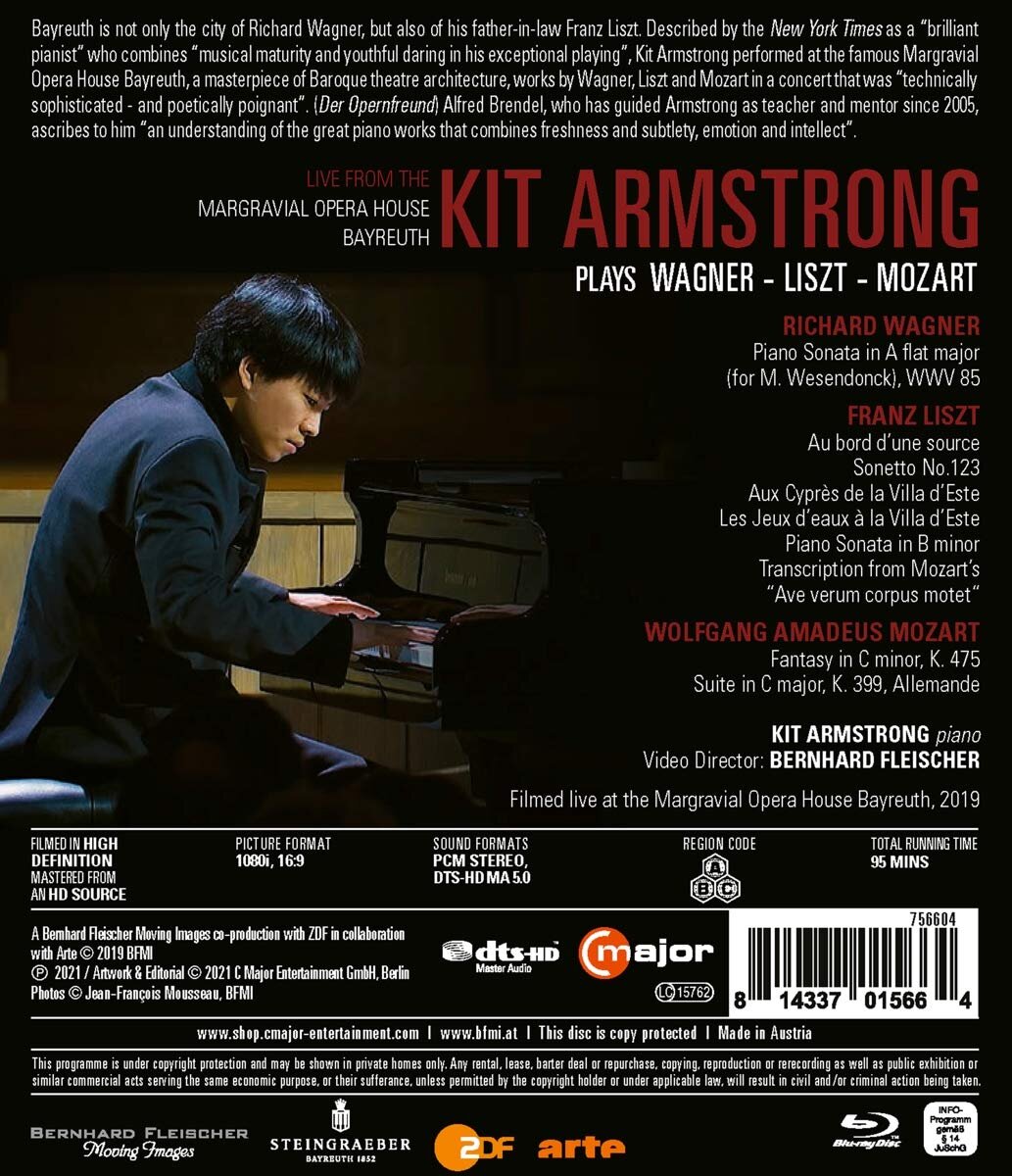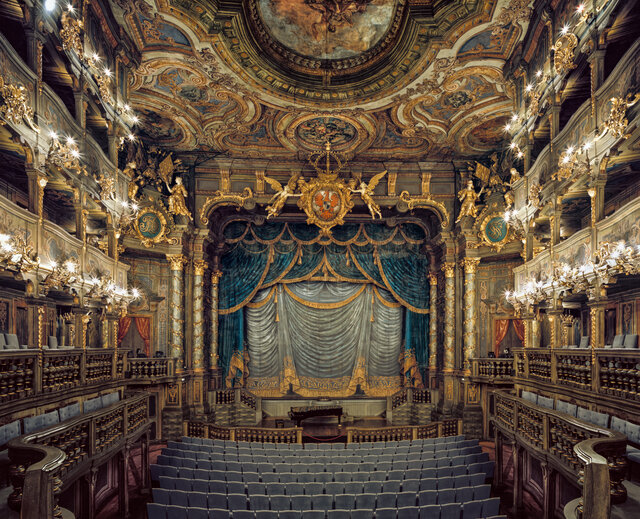

Kit Armstrong Plays Wagner - Liszt - Mozart recital. Performed 2019 at the Margravial Opera House Bayreuth. Here is the program:
Wagner Piano Sonata in A flat major WWV 85
Liszt Au bord d’une source (On the Edge of a Spring)
Liszt Sonetto No. 123
Liszt Aux Cypres de la Villa d'Este (To the Cypresses of the Villa d’Este)
Liszt Les Jeux d’eaux à la Villa d'Este (The Water Games [Fountains] at the Villa d'Este)
LIszt Piano Sonata in B minor
Liszt Transcription from Mozart’s “Ave verum corpus motet”
Mozart Fantasy in C minor
Mozart Suite in C major Allemande
Directed for TV by Bernhard Fleischer. Released 2021, disc has 5.0 dts-HD Master Audio sound. Grade: B+
A young music and mathematics genius of the glittering 21st Century transports us in his time machine to a darker, more romantic world (before electricity) when Mozart, Liszt, and Wagner performed. The young man is Kit Armstrong, the Chinese/British American piano prodigy, who wants us to enjoy not just the music, but also a glimpse into the past. But before we get into his performance, let’s look at the venue in Bayreuth, Germany as it appears today. The Margravial Opera House in Bayreuth is not to be confused with Wagner’s Festival Opera House. Here’s a modern picture of the auditorium at the MOH made by a photographer armed with still-photography gear that can do wonders even with dim light:
Finished in 1748, the Baroque style building is constructed entirely of wood and textiles. It’s considered the finest example of a theater in Germany where the “authentic sound of Baroque court opera culture and acoustics” can be experienced. Next below is the deep stage. The mysterious illusion of a structure receding in the distance is, of course, just an elaborate set painting (and maybe some of the curtains also). It’s all rather impressive!
And here’s the stage set up for a piano recital. It’s nicer than where I played my last recital in the 4th grade. All this probably made even Kit a bit nervous:
The front of the house:
Now let’s see what the Margravial auditorium really looks like in the next three images below taken from subject title. Compared to still photography, video cameras can only show more or less what’s really there. The theater is almost lugubriously spooky looking. And if Mozart, Liszt, or Wagner ever played there (all three could have, but I can find any proof any of them did) the room would have looked even darker because the light would have come from candles or gas lamps. As you will see later, the audience looks a bit ghostly with all the white shirts. This video was made in July when a German day lasts 16 hours, and the ancient hall has no air conditioning. This really is roughing it, just like in the time of Mozart, Liszt, and Wagner. If Edgar Allan Poe had visited this place, he surely would have written a horror story about it:
In the shot next below, look carefully below Kit’s feet and you will see the top another piano located on the floor of the auditorium. This is the only recital I’ve seen where two different grand pianos will be used (more later on this). Kit is sitting at a piano that is an exact replica of the last grand piano owned by Liszt. On the right next to the wall you see what might be a ghost cloaked in a black cape—of, course, it’s only a cameraman trying to hide:
And next below is a low-angle shot that shows how canvas is used for the deep-stage illusion:
Kit performs the top 5 pieces of his program on the Liszt replica grand. The Steingraeber & Sons piano company in Bayreuth has been making a small number of exquisite grands each year for many generations. Next below is a closer look at the “Liszt“ Edition 200 dating from 1890. The reason for using the older piano first is to transport you back to the sound world of the 19th century—a sound world that matches the gloomy surroundings in the Margravial structure with (to my ear) gritty, tubby, harsh bass and percussive treble notes. (In the keepcase booklet the sound is called “dark and somber.”) So Kit’s time machine consists of a venue, instrument, and program from an earlier era. You may well never experience a better rendition of what piano performances of the 18th and 19th centuries were like:
About half way through the evening, Kit moves from the Liszt piano to a modern E-272 Steingraeber. Myth has it that when Lizst played, women threw their garments to him on the stage and Liszt destroyed pianos with his bare hands. Well, this is not Kit’s style. But for his rendition of the Liszt Piano Sonata in B minor, Kit wanted a modern instrument that would yield the best possible sound:
Kit plays the hardest music, but he takes a different approach perhaps from some of the other A-list soloists today. Kit doesn’t go for maximum speed with accuracy. His approach is described in the booklet as follows: “Armstrong imparts every note with importance. He articulates every single tone as part of an autonomous melodic line. There are no ‘accompanying voices’ for this pianist.”
Kit plays Les Jeux d’eaux à la Villa d’Este (Water Games [Fountains] at Villa d’Este) as his last number on the old Liszt piano. This piece appears also on the new Woodlands and Beyond Blu-ray by Hélène Grimaud. And I also have an old CD recording of this by Jenö Jandó on Naxos. So I used my stopwatch to time all three. Grimaud and Jandó both try to create, by playing this a fast as they can, the impressionistic effect of water shimmering. Grimaud clocks in at 7:09 and Jandó at 7:14. Kit comes in slower at 7:52—he wants you to catch every individual glimmer of light reflected by the water. Would Kit try to play the Water Games faster on a modern piano? I doubt it.
Probably most recordings of the Liszt Piano Sonata are played in a bit less than 30 minutes—Kit covers it in about 32 minutes. The fact that he plays it a bit slower doesn’t effect the drama of his interpretation to me. You can hear every note cleanly played and his conclusion is extremely powerful.
Kit’s personal physical style of playing is utterly self-effacing as he doesn’t want to contaminate the music with superficial showmanship. Below is my personal favorite portrait of Kit and another with the greatest show of emotion we get from Kit. All the energy he has is directed toward perfecting his concept of respecting each note:
All the shots above, except the portrait of Kit, are what we call “realistic” screenshots—they could have been seen by someone in the audience with the naked eye or with opera glasses. But there are also in this video many shots we call “unrealistic” in that they could not be seen from the audience. The next three screenshots below are all unrealistic. We consider them less valuable generally than realistic shots because they require the viewer in the home theater to expend extra energy figuring out how they relate to what we are used to seeing:
Sometimes the difference between a realistic image and one that is unrealistic is small. For example, the shot left below is realistic because it could have been seen from a box seat. But the image on the right is unrealistic because it could be seen only from a wing and not by a member of the audience:
Sometimes an unrealistic image is so interesting that we would call it a great shot. For example, the unrealistic image below shows how Kit attacks with 4 fingers that ffff low note in the Liszt Sonata!
Finally, below are a couple of unforced errors: a “hair-shot” on the left and a mess on the right. A professional musician works for 1 and 1/2 hours without missing a single note. The videographer must also produce his file with no unforced errors:
Only a piano expect (which I am not) could try to comment on Kit’s playing. I can only say I admire his intellect for putting us in his time machine as well as his artistry in making every note count. SQ is fine throughout. PQ is also excellent, especially considering the low light, with great resolution and color balance. So at this point we have an A+ title.
But alas, there is a problem with video content. I ran the numbers on a Wonk Worksheet. In a program of about 1 and 1/2 hours, there are a total of 674 individual clips. Included in this total are 18 shots of the building and the audience while Kit is playing, of which I consider half to be low-value. The overall pace works out to 8.4 seconds per clip on average. Also, 48% of the shots of Kit are unrealistic, which is too many.
Why are there so many different clips of one man playing a piano? It seems the answer is that the video director was trying to enhance the recording with a multitude of clever shots including many faster, shorter clips when the tempo of the music is faster. This is perverse. Kit’s goal of letting the music speak for itself without external distractions is frustrated when the video director starts showboating with his images. Also, the video director should slow down [not speed up] the rate of clips when the music is faster or more dramatic. This should be done to make it easier for the home theater audience to follow what is happening. Finally, unrealistic shots should be used sparingly (not too much pepper on the pizza).
So the opportunity to make one of the best piano recordings ever was lost and the grade must be reduced from A+ to B+. This is still a good grade, but it’s a shame to see Kit’s work marred by a video director overworking the project.
OR





















